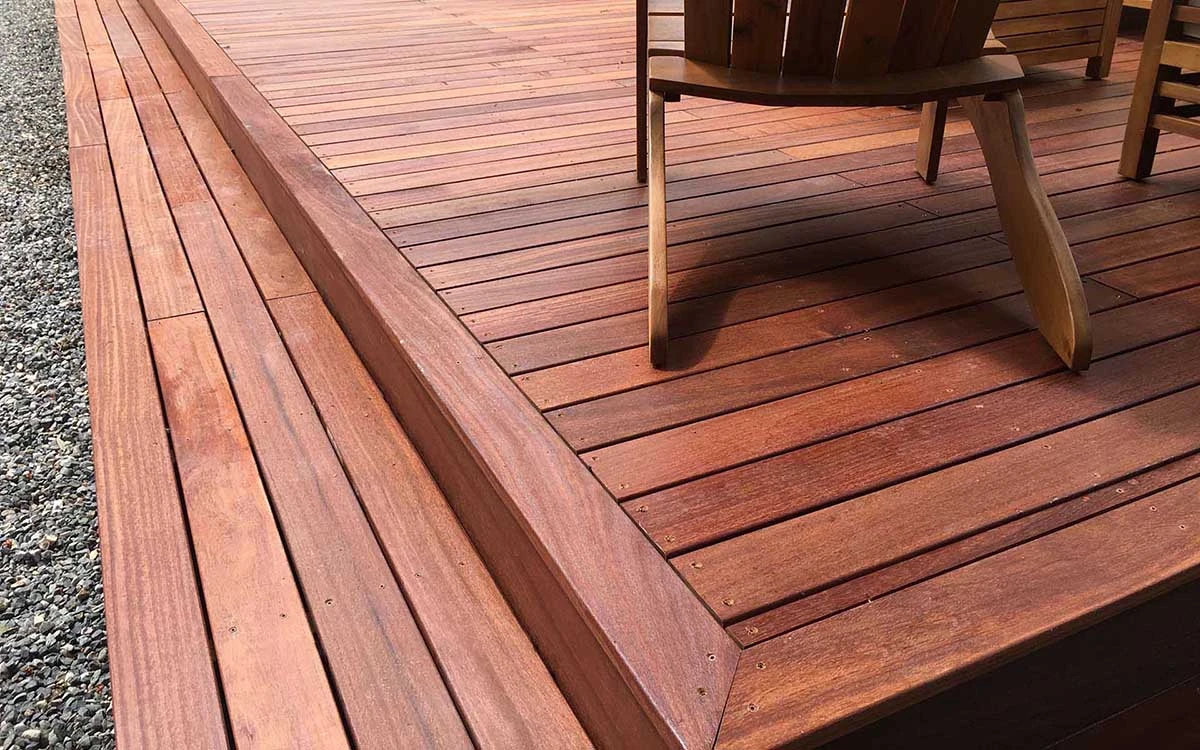Introduction to Wooden Deck Flooring
Wooden deck flooring is a timeless and versatile choice for enhancing outdoor spaces. It represents a harmonious blend of natural aesthetics and practical functionality, making it a popular option for homeowners looking to create an inviting and functional outdoor area.
At its core, wooden deck flooring comprises timber planks that are expertly designed and crafted to withstand the rigors of outdoor use while exuding a warm, organic charm. This type of flooring offers a unique connection to nature, as it allows you to enjoy the beauty of wood while basking in the open air. Whether you’re sipping your morning coffee, hosting a barbecue, or simply lounging in the sun, a wooden deck provides an inviting surface that adds character to any outdoor setting.
One of the key advantages of wooden deck flooring is its durability. When properly maintained, wooden decks can withstand the test of time, offering longevity that few other materials can match. Moreover, wooden decks are known for their sustainability, as they can be sourced from responsibly managed forests, reducing the environmental impact.
Wooden deck flooring offers a diverse range of design possibilities. From classic to contemporary, the versatility of wood allows for various styles and configurations to complement your home’s architecture and your personal taste. Whether you prefer the rustic charm of cedar, the rich tones of redwood, or the affordability of pressure-treated lumber, you have a plethora of choices to match your specific needs and preferences.
In essence, wooden deck flooring is more than just an outdoor surface; it’s a canvas for creativity and a platform for countless outdoor activities. It’s a space where you can relax, entertain, and connect with nature, all while adding significant value to your home. As we delve deeper into this topic, we will explore the different aspects of wooden deck flooring, from choosing the right material to installation and maintenance, helping you create your dream outdoor oasis.
Choosing the Right Material
Selecting the right material for your wooden deck flooring is a crucial decision that can significantly impact the longevity and aesthetics of your outdoor space. Several wood types are commonly used in deck construction, each with its own unique characteristics.
Cedar, known for its natural beauty and resistance to decay, is a preferred choice for many. It has a pleasing aroma and a distinctive grain pattern that adds visual appeal. Redwood is another popular option, valued for its rich color and durability. Both cedar and redwood contain natural oils that act as a defense against insects and decay.
Pressure-treated lumber, on the other hand, is a more budget-friendly choice. It’s chemically treated to resist rot and insect damage. While it may not possess the same natural beauty as cedar or redwood, it offers durability and affordability, making it an attractive option for many homeowners.
Exotic hardwoods like Ipe and Cumaru are known for their exceptional durability and resistance to decay. These woods are dense, making them ideal for areas with high traffic and exposure to the elements. However, they tend to be pricier and may require special tools for installation.
The choice ultimately depends on your budget, aesthetic preferences, and maintenance capabilities. Consider your local climate and how it may impact your chosen wood type. Regular maintenance, such as sealing and staining, is essential for prolonging the life of your wooden deck, regardless of the material you choose. By selecting the right material for your specific needs, you can ensure that your wooden deck flooring remains a beautiful and functional addition to your outdoor space for years to come.
Deck Design and Layout
Designing your wooden deck is a critical step in creating an outdoor space that’s both visually appealing and functional. Careful consideration of the layout and design elements can transform your deck into a captivating extension of your home.
Begin by evaluating the available space and its relationship to your home’s architecture. The size, shape, and orientation of your deck should complement your house and the surrounding landscape. For instance, a square deck might work well with a modern home, while a curved or multi-level deck can add interest to a more traditional setting.
The placement of key features such as seating areas, dining spaces, and outdoor cooking facilities should be strategically planned to maximize usability. Consider incorporating built-in benches, planters, or pergolas to define different areas and create a cohesive look.
Safety is paramount in deck design. Ensure that railings, if needed, meet local building codes and provide adequate protection. Stairs should be well-placed and easy to navigate.
Materials also play a vital role in design. The choice of wood type, stain color, and finish can significantly impact the aesthetics of your deck. You can opt for natural wood tones for a classic look or explore bold, contemporary finishes for a more modern appeal.
Incorporate lighting to extend the deck’s functionality into the evening hours. Recessed deck lights, string lights, or lanterns can create a warm and inviting atmosphere.
Ultimately, your wooden deck’s design and layout should align with your lifestyle and personal preferences. A well-thought-out design ensures that your outdoor space becomes a harmonious retreat that seamlessly integrates with your home and offers years of enjoyment.
Installation Process
The installation process for your wooden deck is a crucial phase that requires precision and attention to detail. Whether you’re a seasoned DIY enthusiast or hiring a professional, following these steps will ensure a sturdy and beautiful outcome:
Prepare the Site: Start by clearing the designated area of any vegetation, rocks, or debris. Ensure that the ground is level and properly graded for water runoff. This step is essential for the longevity of your deck.
Foundation: Depending on your local building codes and soil conditions, choose between concrete footings or deck blocks to create a stable foundation. Properly spaced footings or blocks will support the deck’s weight and prevent it from sinking or shifting over time.
Framing: Construct the deck frame using pressure-treated lumber. Joists should be spaced according to your deck plans and local building codes. Ensure that the frame is level and square. Attach the ledger board to your house securely, providing a stable connection.
Decking Installation: Lay the wooden decking boards perpendicular to the joists, leaving a small gap between each board for water drainage and expansion. Use stainless steel or galvanized screws or nails to fasten the boards securely. Consider using hidden fasteners for a sleek look.
Railings and Stairs: If your deck is elevated or more than 30 inches above the ground, install railings that meet local safety codes. Stairs should be properly designed and constructed, with handrails on both sides for safety.
Finishing Touches: Add finishing touches like trim, fascia boards, and lattice skirting to enhance the deck’s appearance. Apply a protective sealant or stain to the wood to protect it from moisture, UV rays, and wear.
Hardware and Accessories: Install any hardware, such as post caps, lighting fixtures, and decorative elements, to complete the look and functionality of your deck.
Inspect and Test: Once your deck is complete, inspect it thoroughly for any loose boards, protruding nails, or structural issues. Test the stability of railings and stairs to ensure safety.
By following these installation steps, you can create a wooden deck that not only adds value to your home but also provides a safe and inviting outdoor space for years of enjoyment.
Maintenance and Care
Proper maintenance and care are essential to ensure that your wooden deck remains in pristine condition and lasts for years. Here’s a step-by-step guide on how to maintain and care for your wooden deck:
Regular Cleaning: Sweep your deck regularly to remove leaves, dirt, and debris. Use a stiff brush or broom to scrub away any stuck-on dirt. Periodically, give your deck a thorough cleaning using a deck cleaner and a scrub brush or pressure washer. This helps prevent mold, mildew, and discoloration.
Sealing or Staining: Depending on the type of wood and your climate, your deck may need to be sealed or stained every 1 to 3 years. This protective coating helps repel moisture, UV rays, and prevents the wood from graying. Follow the manufacturer’s instructions for the specific product you choose.
Inspect for Damage: Regularly inspect your deck for any signs of damage, such as loose boards, protruding nails, or cracked wood. Address any issues promptly to prevent further deterioration.
Deck Board Replacement: Over time, some deck boards may become warped, rotted, or damaged. Replace these boards as needed to maintain the integrity and safety of your deck.
Lubricate Hardware: If your deck has hardware like hinges, latches, or gate mechanisms, apply lubricant to prevent rust and ensure smooth operation.
Trim Vegetation: Trim back any overhanging branches or shrubs that can drop leaves or sap onto your deck. This helps prevent staining and reduces the risk of mold growth.
Use Furniture Protectors: If you have outdoor furniture on your deck, use furniture protectors or coasters under the legs to prevent scratching and water damage.
Snow and Ice Removal: In winter, use plastic shovels or rubber-edged snow blowers to remove snow and ice from your deck. Avoid using metal shovels or sharp tools that can gouge the wood.
Rust Removal: If you have metal components on your deck, such as railings or furniture, promptly remove any rust with a wire brush and treat with a rust converter before repainting.
Refinishing: Sand and refinish your deck every few years to maintain its appearance. This involves sanding down the old finish and applying a fresh coat of stain or sealer.
By following these maintenance steps, you can ensure that your wooden deck remains a beautiful and safe outdoor space for relaxation and entertainment, extending its lifespan and preserving its natural beauty.
Conclusion
In conclusion, a well-maintained wooden deck is a valuable addition to any home, offering a beautiful and functional outdoor space for relaxation, entertainment, and connection with nature. Throughout this guide, we’ve explored the various aspects of wooden deck flooring, from selecting the right material to design, installation, and maintenance.
By carefully choosing the appropriate wood type, whether it’s the classic charm of cedar and redwood or the affordability of pressure-treated lumber, you can tailor your deck to your preferences and local climate conditions. The design and layout of your deck should harmonize with your home’s architecture and create a welcoming atmosphere for your outdoor activities.
During the installation process, meticulous planning and construction ensure the structural integrity of your deck. Proper foundations, framing, and finishing touches contribute to its longevity and visual appeal. Maintenance and care are paramount, as routine cleaning, sealing or staining, and inspections can protect your deck from the elements and wear and tear.
Ultimately, your wooden deck is a versatile canvas for your creativity and outdoor enjoyment. Whether you envision it as a space for family gatherings, a quiet retreat, or an alfresco dining area, with the right materials, design, and maintenance, your deck can fulfill your vision and provide lasting value to your home.
So, embark on your wooden deck flooring journey with confidence, knowing that with the right choices and care, your outdoor oasis will continue to shine for years to come.




